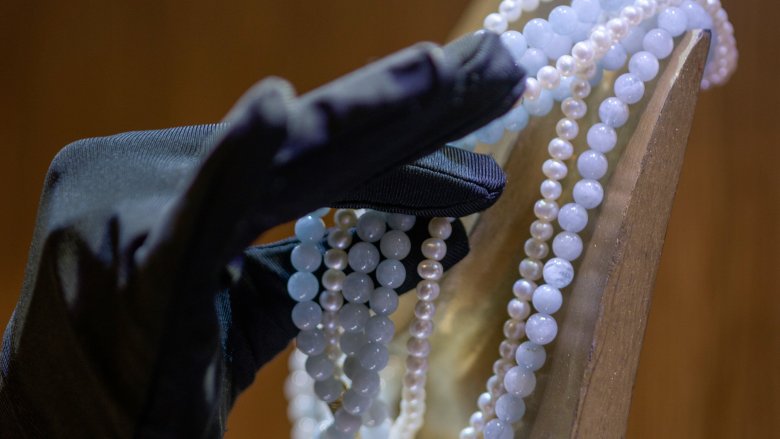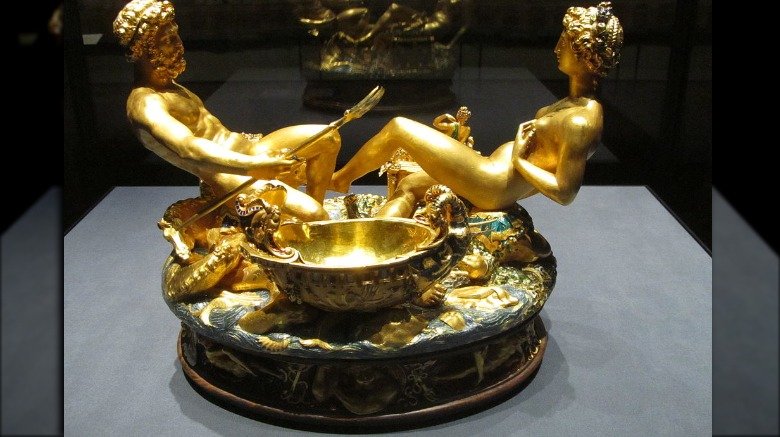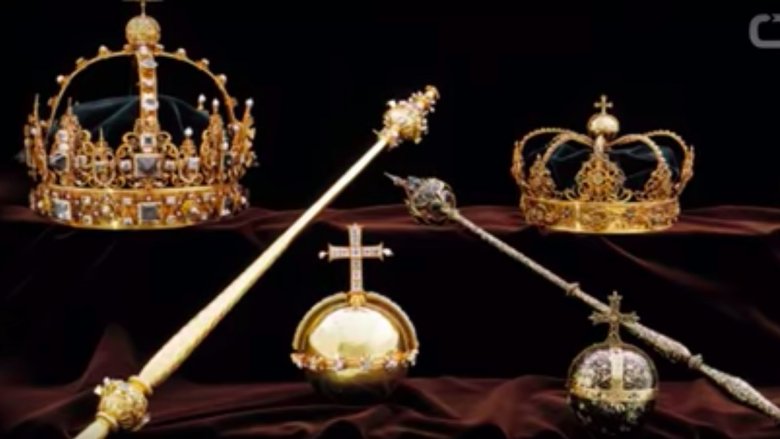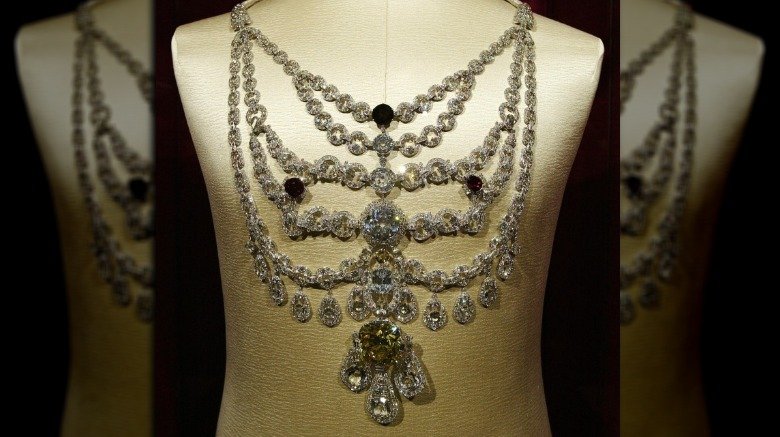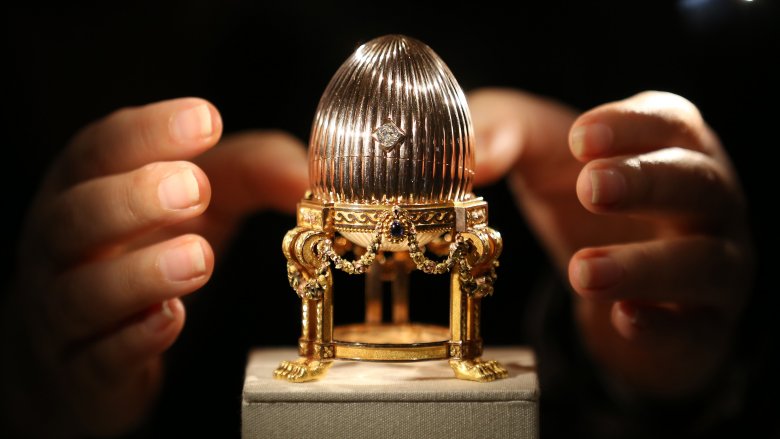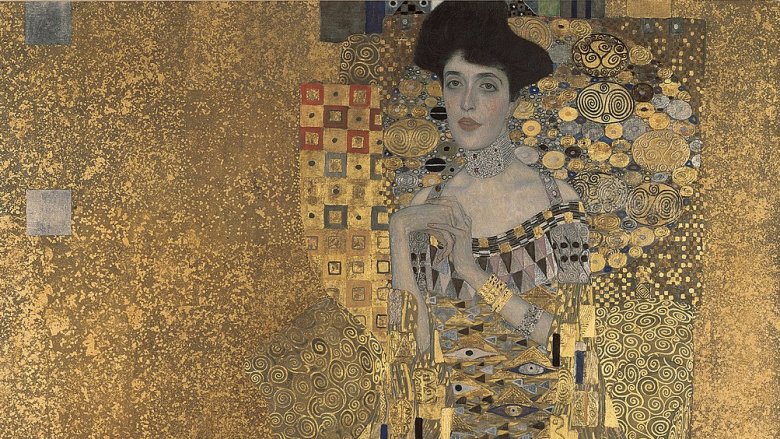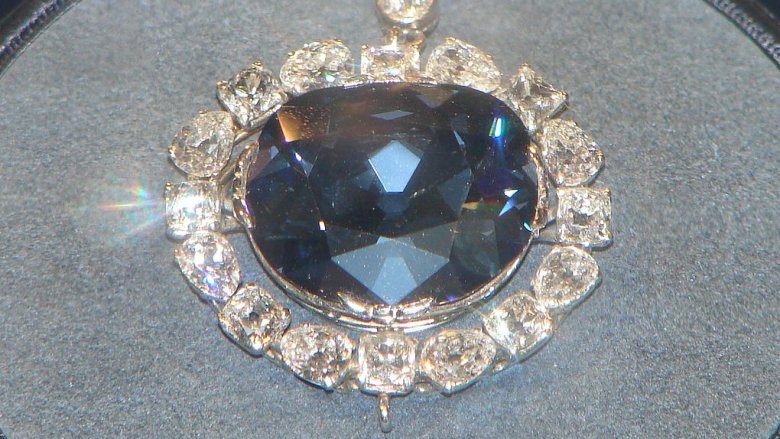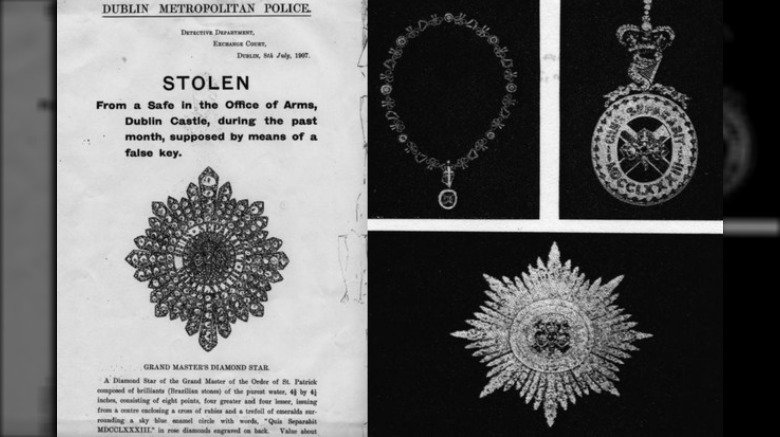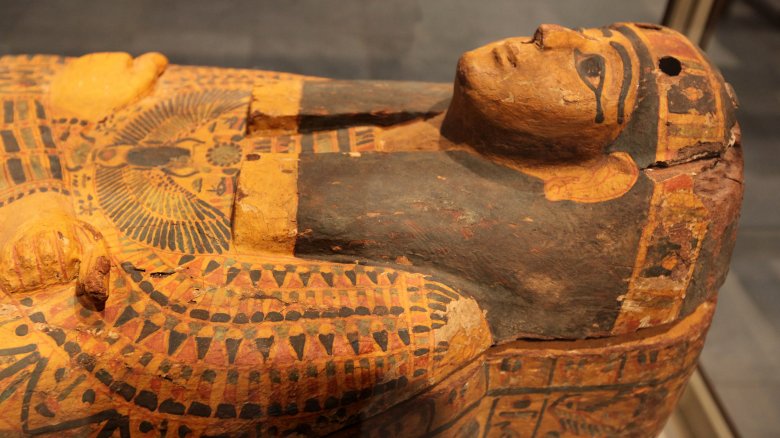The Most Expensive Items Ever Stolen
Human beings have been collecting beautiful things since the dawn of time. It's what separates us from all other animals, except magpies and pack rats. And as long as human beings have been collecting beautiful things, other human beings have been stealing them. Grave robbers were hard at work in ancient Egypt, and before that cavemen were probably bludgeoning each other over seashells and especially cool-looking rocks.
As humans evolved, so did our taste for things that sparkle, until we were no longer satisfied with objects that were simply shiny — they had to be shiny, jewel-encrusted, unique among all other things, and also expensive enough to make our friends really jealous. And with that level of opulence came safes, armed guards, sophisticated security systems, and thieves who were clever enough to outsmart all of it. Here are a few of the most expensive items anyone ever dared lift from a wall, a house, or Carnegie Hall.
An obscure painting, which is not-so-obscure anymore
It probably wouldn't be a stretch to say the Mona Lisa is the most famous painting in the world. But would it be anywhere near as famous as it is right now if it hadn't been stolen in 1911? According to NPR, the Mona Lisa was obscure for hundreds of years. Painted in 1507 by Leonardo da Vinci, no one really paid much attention to it until the 1860s when a small group of French art critics finally decided it was worthy of praise. Even then, the painting was so under-celebrated that it was gone for more than a day before anyone even noticed.
Overnight, the 30x21-inch painting became famous — not because the world realized it was a masterpiece but because everyone was all, "Cool, a scandal and a mystery!" Some people blamed American millionaires, some people blamed the Germans, and some people evidently blamed Pablo Picasso, who was actually questioned by investigators. The empty spot where the painting had once hung became one of the Louvre's most popular attractions.
The thief, Vincenzo Perugia, kept the painting for more than two years, but by then it was so famous that his attempt to sell it to an Italian art dealer inevitably resulted in his arrest. No one remembers much about him, but now everyone knows the Mona Lisa, which was given an insurance value of $100 million in 1962 — the equivalent of around $822 million in 2018 dollars.
This weird little gold piece of tableware you've never heard of
In 2003, a "security expert" climbed the scaffolding outside Vienna's Art History Museum, broke a window, evaded motion sensors and the museum's 24-hour guard staff, and stole a 10-inch gold sculpture called "La Saliera." He then buried it in the woods in a lead box and demanded a ransom for its return.
For a dude who knew pretty much everything there is to know about how to outwit a sophisticated security system, he made one very, very stupid mistake — he bought a brand new cellphone and used it to text the police. Duh. He turned himself in after surveillance footage from the shop where he bought the phone became public.
According to Reuters, La Saliera was commissioned by the French king Francis I in the mid-1500s, and it was originally meant to serve as a salt dish. Not even a salt shaker because it was really just a bowl; if you wanted to actually get salt out of it you had to just pinch it out with your fingers. This glorified piece of gold-plated tableware features Neptune, the god of the sea, and Ceres, the goddess of agriculture, who evidently have nothing better to do than sit around next to a bowl of salt and appreciate in value. Today La Saliera is worth about $60 million.
A priceless pair of gold crowns that would be impossible to sell
If you're going to steal treasure, you might as well go all out. Why settle for a painting or some weird sculpture no one has ever heard of when you can have a crown? Who cares if you can't actually ever sell it because it's priceless and you'd get caught pretty much immediately — it's a crown.
That was thinking of two unknown persons who, in July 2018, stole not one but two crowns and a royal orb, and then escaped in a speedboat like freaking James Bond. Sadly, the Telegraph report does not make note of whether the boat leaped over any cars or escaped via waterfall, so we'll just have to hope.
The two crowns date to 1611 and were meant to be buried permanently with King Karl IX and Queen Christina of Sweden, but at some point officials decided it was better to dig them up and put them in a display case in a 14th-century cathedral. The thieves didn't seem to have much trouble — they just smashed the glass, took the jewels, and made off in their boat. The jewels are said to be priceless, though, so it's not really clear what the thieves planned to do with them. Two suspects were later arrested, but as of this writing the jewels have yet to be recovered.
This very tacky yet super expensive necklace
Your grandma probably has a necklace that looks like this. Grandma's is costume jewelry (because Grandma isn't a billionaire), but as far as tacky goes, this thing totally looks like something that would be in your grandma's collection.
According to India Today, the Patiala necklace was made by Cartier for Maharaja Sir Bhupinder Singh of Patiala in 1928. It featured platinum chains set with Burmese rubies and 2,930 diamonds, including the DeBeers diamond, which was the seventh largest in the world. The Maharaja wore it for 20 years, and then in 1948 it disappeared, maybe because someone in the family wanted to save grandma from the embarrassment of going to a party while wearing such a hideous thing, but more likely to sell it for profit.
When the Patiala necklace resurfaced 50 years later, it had been picked over — the DeBeers diamond was gone, and so were most of the rubies. Cartier restored it, but without those original stones, it would never again be its spectacularly tacky self. Shame. Still, the thing was worth $50 million, so whatever. No one says you actually have to wear the ugly thing.
The Easter Bunny was never this good to you
It's probably a safe bet that no one ever gave you an Easter egg quite like the ones the Russian Imperial family commissioned from Faberge. Alexander III Romanov began the tradition and his son Nicholas II continued it — each year Nicholas gave one to his mother and one to his wife. The tradition ended in 1917 with the 50th imperial Easter egg, not because the Romanovs got bored of the same old, tired, jewel-encrusted Easter gifts, but because they were executed by the Bolsheviks, which really hampered their commissioning more Faberge eggs. Anyway according to the Daily Beast, the Bolsheviks seized the eggs and most of them were sold to help finance the new regime. Eight of them went missing.
Then, nearly 100 years after the Bolshevik revolution, some guy in the midwestern United States found a gold egg at a market and bought it for $14,000, hoping he could sell it for scrap and make a $500 profit. The scrap dealers, who are probably still kicking themselves, told him the egg wasn't worth what he wanted for it. So he Googled an inscription he found on the clock inside the egg, discovered it was worth $33 million, and (presumably) lived happily ever after.
He's screaming because he just found out how much he's worth
Edvard Munch's The Scream is probably more famous for its memes and parodies than it is for being a masterpiece. Even the artist himself couldn't get enough of the scene — he painted it four times. According to the Smithsonian, in 2004, one of the four paintings was stolen from the Munch Museum in Oslo, Norway. Weirdly, it was not taken in some inside-job scheme, but just grabbed at 11 a.m. by two dudes in ski masks. The thieves stole The Scream and another famous Munch painting at gunpoint, which as it turns out was quite an easy task since none of the guards working at the museum were armed.
The pair made off with the paintings, presumably paying no heed to the museum guards' distressed cries of "Stop, please!" The paintings were recovered a couple years later and both thieves were brought to justice, but no one is really sure of the motive behind the crime. Famous stolen paintings are notoriously difficult to sell, so it's not like art thievery is necessarily lucrative. Maybe they wanted to turn it into a $100 million meme? The world may never know, but it may have been to distract police from investigating a murdered cop.
So how exactly does one play a $15 million violin without dying of anxiety?
Most notable "treasures" are either masterworks of art, or solid gold, jewel-encrusted objects that say, "Rich people have access to way too much money." Some treasures are more than that, though. They aren't just visual marvels, they're masterpieces of craftsmanship, designed not just to be beautiful but to create beauty. Some of the best-known such treasures are the Stradivarius violins, which were made by Antonio Stradivari (1644-1737). There are only about 650 surviving Stradivarius instruments (they aren't all violins), and their value makes them the sometimes-target of opportunistic thieves.
According to the New York Times, in 1919 the Gibson Stradivarius was stolen from a violin teacher in Vienna. It was recovered the next day but was stolen again in 1936 from a dressing room in Carnegie Hall. It eventually ended up in the hands of cafe violinist Julian Altman, but no one is really sure if he was the thief or if he bought it for $100 from the actual thief, which is the story his wife told after his death. Either way, the violin was returned to Lloyd's of London, who paid the insurance claim for its loss back in 1936. Today, the Gibson Stradivarius is owned by violin virtuoso Joshua Bell, who told TMZ in 2014 that the instrument was then worth a cool $15 million.
Give me my painting back because I want to sell it
One of the Nazis' less-despicable crimes was the theft about 20 percent of Europe's great works of art. Of course, that's actually really, really despicable, but when you have genocide to compare all your other crimes to then pretty much everything seems tame by comparison.
Anyway, one of the many paintings stolen by the Nazis was Gustav Klimt's Portrait of Adele Bloch-Bauer, which is arguably his most famous painting — a glittering image of an elegant lady dressed in gold. It was taken to the national gallery in Vienna after the Nazis pillaged it from the Bloch-Bauer home in 1941. According to NPR, the Nazis even went so far as to change the name of the portrait to "The Dame in Gold," since they couldn't have anyone believing they liked and admired a portrait of a Jewish woman or anything.
The portrait remained in Vienna until 1998, when Bloch-Bauer's niece demanded its return and an Austrian court found in her favor. She didn't really seem interested in keeping it in the family, though, because she turned right around and sold it for $135 million to a cosmetics mogul. The painting is now on display at the Neue Galerie in New York.
Don't steal this diamond. Just don't.
The world's most famous diamond is almost certainly the Hope Diamond, although it's by no means the biggest. (The honor of world's largest cut diamond goes to the Golden Jubilee, which weighs a massive 545.67 carats compared to the Hope Diamond's measly 45 carats.) What makes the Hope Diamond such a legend isn't just its beautiful blue color but its history — not only was it stolen, it's also supposed to be cursed. So just in case you were thinking that you might buy yourself a Hope Diamond with that extra $250 million you have laying around, you should maybe look into buying a yacht instead.
According to Live Science, the Hope Diamond was first stolen by a Hindu priest, who died "a slow and agonizing death" as punishment for the crime. It then ended up in the hands of a French merchant, who was supposedly mauled to death by wild dogs shortly after he sold it to King Louis XIV. The diamond was stolen again, around the same time as Louis and his wife, Marie Antoinette, were beheaded by French revolutionaries. A smaller, recut version of it resurfaced in the mid-1800s, and by 1839 it belonged to Henry Thomas Hope (hence "Hope Diamond"). After that it had a succession of owners, all of whom were said to have suffered terrible misfortune from financial ruin to suicide. Today it's in the Smithsonian. You may want to give it a really, really wide berth.
I'm going to steal that but I'm not sure how it's going to fit in my pocket
Most of the valuable things people steal are at least marginally easy to conceal. You can put a diamond in your pocket, and most people on the street won't notice if a busker is playing a $15 million violin or one from Dollar General. But how exactly does one disappear an entire room?
The "Amber Room" was once described as the eighth Wonder of the World, which by itself is not really that impressive since like a bazillion things have also been called the eighth Wonder of the World, from Andre the Giant to the Foxconn plant in suburban Milwaukee.
Anyway according to the Smithsonian, the Amber Room was yet another seriously excessive glittery treasure owned by Russian royalty — it was given to Peter the Great in 1716 and was basically 6 tons of amber embellished with gold leaf and semi-precious stones. Eventually the Nazis came along, said "That's cool," packed it up and shipped off to Kaliningrad, Germany, where it was installed in a museum on the Baltic Coast. Toward the end of World War II, the museum's curator was told to tear it down again to protect it from Allied forces, and after that no one really knows what became of it, although one theory is that it was burned by Soviet soldiers. If by some chance it did resurface, it would be worth anywhere from $140 to $500 million.
Those other crown jewels
Crown jewels are a popular target for thieves, despite the fact that it's next to impossible to actually sell them to anyone after they're in your possession. That doesn't stop people from trying, though. In 1671, a man named Thomas Blood attempted to steal the British crown jewels, was caught, and then was punished with a full pardon and given Irish lands valued at 500 pounds a year, so it rather worked out for him. A couple of centuries after that, one or more thieves actually did steal the Irish crown jewels, so they didn't get a pardon and their own lands and might not have ever got rich off the acquisition, either.
The jewels were taken from Dublin Castle in 1907, and just to clarify, Irish Central says they were not royal jewels but the "star and badge regalia of the Sovereign and Grand Master of the Order of St Patrick." They were studded with emeralds, rubies, and Brazilian white diamonds, and today would be worth about $20 million.
There were several suspects, but the most likely was Francis Shackleton (the brother of Antarctica explorer Ernest Shackleton). Shackleton had the opportunity — he was the subordinate of Sir Arthur Vicars, who was the only guy with the keys to the safe and was quite often drunk and incoherent. But Shackleton was never charged with the crime, and to date no other suspect has ever been named.
And now, the weirdest of the most expensive items ever stolen...
Even if you don't have a brilliant criminal mind, you can almost certainly see the appeal of stealing a gigantic diamond or the crown jewels or a painting that you'll have to hide in a box somewhere in case someone recognizes it, but an ancient Egyptian coffin? Even if you could manage to smuggle that out without anyone noticing, what are you going to do with it?
In 2015, U.S. Homeland Security and Immigration and Customs Enforcement (yes, ICE) announced they'd identified a network of smugglers, dealers, and unscrupulous collectors that had been dealing in stolen artifacts within the United States. Most of the artifacts came from politically turbulent nations where they were easier to steal and the thefts were less likely to be noticed. Investigators seized 7,000 artifacts, which is actually a small percentage of what is thought to have been stolen. Among those artifacts was the three-part nesting coffin of Shesepamuntayesher, an Egyptian woman who lived 2,600 years ago. One of the three parts had been cut into pieces to make it easier to ship via U.S. Express mail, so the thieves were those kinds of thieves.
National Geographic says the coffins are still valuable, even in their damaged state, but they would have been priceless if they'd been excavated with the kind of care that actual archaeologists use when recovering ancient artifacts. Well, maybe the mummy's curse really is thing. We can only hope.
